EAA AirVenture Oshkosh 2021 is one for the history books. Initial reporting from the big member organization suggests 2021 was a return to normal attendance and exhibitors were not far behind.
 One can always find a few empty spots and wonder if they failed to sell yet it is equally likely a company bought the space but could not attend or exhibit for a variety of reasons. To my eyes and by the numbers, Oshkosh 2021 looked to be a home-run success.
One can always find a few empty spots and wonder if they failed to sell yet it is equally likely a company bought the space but could not attend or exhibit for a variety of reasons. To my eyes and by the numbers, Oshkosh 2021 looked to be a home-run success.
Stories will continue but here I want to address two very different views of AirVenture. On one hand vendors widely reported solid sales. On the other, FAA clarified some questions but raised others. Many frowns were reported when agency boss Steve Dickson held his “Meet the Administrator” session but let’s look at the bright side first.
LSA – SP Kits – Ultralights
Sold Well at Oshkosh
I did no survey and even if I had, what a vendor reports and what actually follows are rarely identical. However, a flow of unsolicited statements suggest that many airplane sellers reported taking multiple orders.
 This is not a pace I heard at Sun ‘n Fun 2021, for example. That first show of the year was more tentative. People were still frightened by unrelenting news on TV and Sun ‘n Fun represented a first step back toward normal. Mind you, I considered the Lakeland show another big success; many others evidently decided by late July that the situation had improved enough for pilots to open their wallets.
This is not a pace I heard at Sun ‘n Fun 2021, for example. That first show of the year was more tentative. People were still frightened by unrelenting news on TV and Sun ‘n Fun represented a first step back toward normal. Mind you, I considered the Lakeland show another big success; many others evidently decided by late July that the situation had improved enough for pilots to open their wallets.
Pilots who acted sooner scored an earlier delivery. Many at Oshkosh heard deliveries were already being quoted well into 2022. At Sun ‘n Fun we didn’t hear that.
My measurement of how the industry is doing is not only to assess the health of suppliers but the willingness of pilot consumers to think about a new purchase. Wary buyers hold back in times of uncertainty so sales of light aircraft at Oshkosh illustrates both pent-up demand and a sense of hopefulness by pilots expecting to get out and enjoy flying.
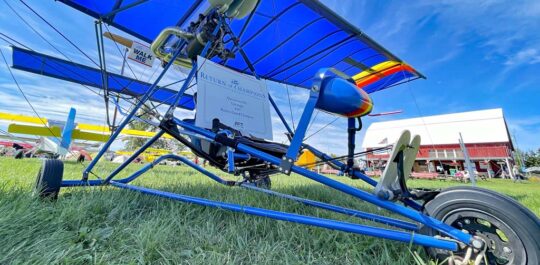
Used aircraft were also for sale and found buyers at AirVenture 2021. This handsome Quicksilver MX was Reserve Grand Champion in 1997. It’s been so well kept, it looked brand new.
At least a dozen producers or representatives told me about two or more confirmed sales (usually meaning money exchanged hands). My back-of-the-envelope calculation projects 30-50 unit sales during the event — and most vendors report better than 1:1 sales after the event compared to sales at the event. If all these come to pass, hallelujah!, the industry is looking alive again.
One segment that recorded excellent sales in the last two years is Part 103 ultralights. Based on multiple entries (see this article or a later one for examples that caught my eye), 103 is a highly active sector within light aviation.
I heard less about sales in the scaled-back kit area of AirVenture, but the Big Five in this sector appear to be continuing their steady business.
Saying “So Long!”
to An American Icon
Longtime readers of this website (very longtime readers, that is) will recall that when ByDanJohnson.com went live, hang gliding was still a significant part of our coverage. As Light-Sport Aircraft arrived in aviation and as ultralights subsequently went into a quiet period, hang gliders faded from my attention.
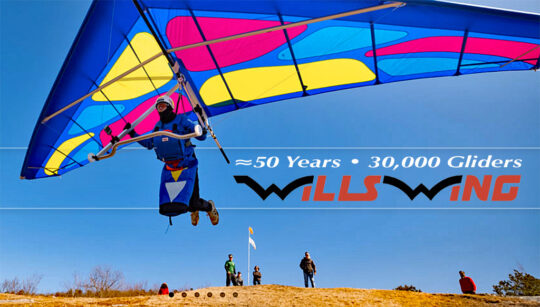
Bidding a very fond farewell to American hang gliding icon, Wills Wing, operating successfully for almost 50 years.
My changed focus, however, said nothing about hang gliding. While that activity has not grown much over the years, it has remained remarkably steady. Just like EAA, membership in the national USHPA (U.S. Hang Gliding and Paragliding Association) has also stayed the course.
Now, a major change is happening as those who gave birth to the industry reach retirement. The longtime leading producer of hang gliders in America, Wills Wing, saw the departure of two key leaders, Mike and Linda Meier. This change triggered a notable development: Wills Wing is moving to Mexico.
“What a fun day test flying the last gliders produced in Orange, California,” wrote Wills Wing president, Steve Pearson. Test flying a couple gliders before delivery to customers, a 235 Alpha and full-carbon T3, he said, “They fly so-so nice! Couldn’t have picked anything that I would have enjoyed more.”
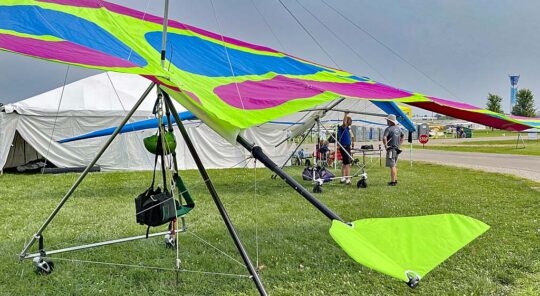
Even as Wills Wing ceased manufacturing in the USA, the regional hang gliding group mounted a display at AirVenture 2021.
Then he added, “All the focus is on Valle from here on.” He refers to Valle de Bravo, Mexico.
Heading up the new south-of-the-border enterprise will be Rudy Gotes, a top-ranked competition pilot, and Wills Wing’s longtime distributor in Mexico. Wills Wing president Steve Pearson will be joining the new company as a partner and will provide critical support in technology, manufacturing, customer support, and product design and development. Production facilities for the new company will be headquartered in Valle de Bravo, Mexico, known around the world for its consistent, year-round flying.
In announcing this historic move, Steve listed some interesting facts: Wills Wing has been in business in California for 48.5 years. Over that time, WW-brand produced an amazing 29,368 gliders for an average of 606 aircraft per year. While hang gliders are much less expensive than airplanes, building 12 gliders a week, 2.5 every day, for 50 years represents a monumental achievement in aviation.
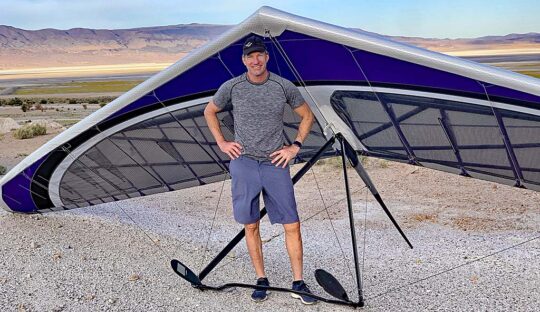
Owen Morse recently flew this very high-tech Wills Wing T3 to an out-and-return world record of 222.22 miles.
Congratulations to a job wonderfully well done for half a century to longtime Wills Wing proprietors — and personal friends of mine — Steve Pearson, Mike & Linda Meier, and Chris Wills.
The lone remaining U.S. producer of hang gliders is North Wing, also a supplier of lightweight trikes plus fully-built SLSA weight shift aircraft.
Stupid Fed Tricks?
Having already written (here about the coming LSA regs and here about the instruction dilemma), I want to bring two additional perspectives to assure readers these concerns are not simply my own opinion. The first is the newest info, AVweb’s July 31 report from AirVenture 2021. The second is composed of two videos that explain the situation in some depth.
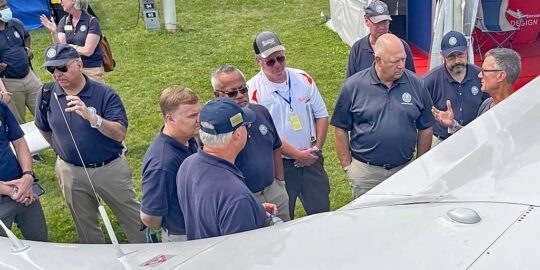
Tom Peghiny (gesturing at right) helps FAA Administrator Steve Dickson better understand Light-Sport Aircraft. “He asked good questions,” said Tom.
I urge you to consider all relevant information. This entire situation exploded into pubic view during the month of July 2021.
For AVweb, journalist Russ Niles reported, “FAA Administrator Steve Dickson said it will take about four years to rewrite regulations governing flight instruction in aircraft other than those in the standard category and until that’s done instructors will need extra paperwork. Speaking at the annual ‘Meet the Administrator’ event at EAA AirVenture last Thursday, Dickson told the generally-disappointed crowd that in the meantime instructors will need a Letter of Deviation Authority (LODA) to teach people to fly in Experimentals. If they want to teach on Limited or Primary Category aircraft, they will need a written exemption. Dickson said he agreed the process is a ‘big documentation exercise, no doubt’ but it is also a legal necessity. ‘I am not any happier about this situation than you are,’ he said.”
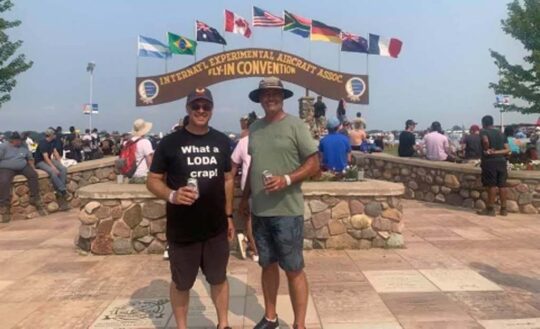
Lots of people expressed their view about LODAs (Letters of Deviation Authority) at AirVenture, some more clearly than others.
Russ continued, “The new requirement came into effect July 12, 2021, a few months after a legal battle with a Florida P-40 operator revealed a contradiction between the regs and the guidance issued by inspectors. ‘We do need to rewrite the rule so that it says what we all want it to say,’ stated Dickson while expressing that the agency is doing everything it can to expedite the LODAs and exemptions and most of those received so far have already been processed. He also said writing a new rule is a complex process that will take four years and that’s why the paperwork has a 48-month term.”
Roy Beisswenger has taken a fresh lead in putting out great video information on FAA’s actions. He was instrumental in aiding LAMA as the manufacturer organization lobbied FAA for improvements and upgrades to Light-Sport Aircraft regulations. In the following two videos Roy does a deep dive into FAA’s latest stumbles.
Two videos are presented below; both are helpful in understanding this situation. Both were prepared before the comments from AVweb above.)
…from July 20, 2021…
…from July 13, 2021…


How did this happen? Who was sleeping at the wheel? Ok so is the off the cuff answer to put students at risk and trainers out of work? How about grandfathering existing trainers without miles of red tape and decades long waits before this ever ending journey ends. A government agency bears the responsibility for this why punish trainers .
What Craig said.
Dan-
Thanks for the update on Wills Wing.
I had no idea they were leaving California (as well all companies should).
I wonder how this will affect their shipping and access to raw stock?
(HG pilot since 1972, and still have an HP 160.)
-Christian
Hi Dan and thanks for the reports. People need to understand that 4 years to change a rule is light speed for the FAA. It is a change in law and there is a process that can’t be just set aside. First someone has to draft that CFR language and then it has to go for review to all the FAA internally. Normally the public and industry will have some time to input this change or new rule before it must then be drafted into final language and go into a public required process called the NPRM, notice of proposed rulemaking. Time has to be given for anyone concerned to review the changes and comment back to the FAA. Each comment must then be adjudicated, it takes time and they cant just shortcut this part as everyone is given due consideration for their comments. Once this is released there is a final review by OMB, office of management and budget in Washington. They must look at the new law and see if there are any concerns and consider the impact on budget if any. These would include administrative costs and the like. To complete all this takes time and to accomplish this legally in 4 years is a reasonable and fast process given the heavy bureaucracy of government today. Let’s be happy they are recognizing the issue and listened to LAMA and USUA solutions.
https://www.federalregister.gov/uploads/2011/01/the_rulemaking_process.pdf
Cheers and thanks Dan.
The purpose of a regulation is to derive procedures from a law. Can you refer me to the “law” that embodies this specific training requirement and a LODA or is it merely an FAA regulation designed by bureaucrats.
Taking four years is a reflection of agency bureaucracy. If the powers that be, i.e. the FAA Administrator, wants to speed up the process, he/she has the ability to do so. Entrenched bureaucracies require leaders [willing] to effect new procedures if they want to change the “four” years it takes for the FAA to get out of their own way. We’ve accepted that the FAA is a behemoth that can’t move quickly unless they want to… like when a judge tells them they misinterpreted their own “regulation”. If you find the “law” that describes a LODA, I will be happy to announce a mea culpa. I doubt it is a law, but like any “law,” it certainly could be buried in the 6,000 pages you have to read to find out what’s in it.
Four years to rewrite a rule is ridiculous and inexcusable. Other than the public comment period, it should take no more than a week. Particularly, as the present rule is impractical and contrary to safe training practices. I realize the FAA has other, perhaps more pressing, matters, but 4 years ?!!
I agree. WAY TOO LONG. Inexcusable bureaucratic BS. We actually pay these incompetents. VERY disappointing.
I always believed that the FAA was an entity that promotes safety in all aspects and categories of aviation. After this new ruling, which completely contradicts its own regulation, has come to light, I’m not so sure that safety is their number one priority anymore. How many Folks will get injured or die because training in ultralights or experimental aircraft because this has become a political issue for those in aviation authority?
Nuts, it took 4 years to win WWII. Here’s an idea. Let’s write the rules governing our sport and tell the FAA administration, “You work for us.”
Agreed!!! The aviation community should tell the FAA what we need!
Great video (FAA new bad idea)
Agreed!